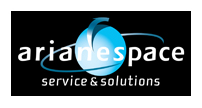Arianespace: 25 years of success, 25 years of meeting the challenge

Le Bourget, France, June 14, 2005 — Created in 1980 as the first commercial launch services company, Arianespace this year celebrates its 25th anniversary.
During its quarter century of operations, Arianespace became the world leader in launch solutions, and has maintained the industry’s no. 1 position.
The reference in space transportation
As of June 14, 2005, Arianespace’s backlog of satellites to be launched totals 41 spacecraft (36 with Ariane 5, of which 9 are ATV resupply spacecraft for the International Space Station; 3 on Soyuz to be launched from the Guiana Space Center; and 2 on Soyuz from Baikonur Cosmodrome). The backlog for its Starsem sister company stands at 5 satellites. Together, this represents by far the largest backlog in the business.
In the past 25 years, Arianespace has signed more than 260 launch contracts with 62 international operators. Today, 65% of the operational commercial telecom satellites in orbit were launched by Arianespace.
A stabilized financial situation
Following the company’s recapitalization in 2004, Arianespace’s shareholding is now concentrated around the Ariane program’s major partners, totaling 23 shareholders. The company’s turn-over for 2004 was 657 million euros, and the net result was 8.3 million euros.
Ariane 5 at the heart of Europe’s space strategy
In 2004, successful launches of the Rosetta space probe, the Anik F2 telecommunications satellite and the Helios 2A reconnaissance platform underscored the maturity of the Ariane 5 Generic vehicle. On February 12, 2005, a completely successful flight of the Ariane 5 ECA confirmed the credibility of this heavy-lift Ariane 5 version.
A complementary family of launchers
Arianespace’s heavy-lift Ariane 5, the medium-lift Soyuz and the lightweight Vega are the three components of Arianespace’s commercial offering – with the latter two launchers becoming operational from the Guiana Space Center in 2008.
For Soyuz missions from French Guiana, the definitive decision was taken during 2004 on construction of the launch facility for this vehicle. All of the legal and financial documents were signed during the first half of 2005. On the launcher side, the Soyuz 2-1a version made its successful first flight on November 8, 2004, while the initial Soyuz 2-1b will fly in mid-2006.
Based on this momentum, Arianespace already has inked the first launch contracts with commercial and institutional customers for Soyuz missions from the Guiana Space Center.
Concerning Vega, the development program for this vehicle is continuing, with its first flight now set for 2008.
The Launch Services Alliance: a true commercial innovation
The back-up mission assurance agreement with Boeing Launch Services (Sea Launch) and Mitsubishi Heavy Industries (HIIA) enabled several contracts to be signed in the framework of this cooperation in 2004. In addition, the launch of DirecTV 7S in 2004 demonstrated that the Alliance is now an operational reality.
Upcoming launches
The next Arianespace launch is scheduled for the night of Thursday, July 7 to Friday, July 8, 2005, using an Ariane 5 Generic vehicle to orbit the IPSTAR-1 satellite on behalf of Thailand telecommunications operator Shinsat.
With a liftoff mass of 6,505 kg., IPSTAR-1 will be the heaviest commercial telecommunications satellite ever launched.
Between now and the end of the year, Arianespace will perform 4 other missions using 2 Ariane 5 Generic and 2 Ariane 5 ECA launchers. For Soyuz, Arianespace and Starsem have slated 3 launches of this vehicle in 2005, with the first scheduled on August 1 to orbit the Galaxy 14 satellite for American telecommunications operator PanAmSat.
Preparing for the future
Arianespace already is preparing to face the challenges of tomorrow. The areas in which Arianespace is ready to act during the months and years to come include the consolidation of Ariane 5’s reliability and industrialization, its participation in future exploration programs, the servicing of the International Space Station, the evolution of the Launch Services Alliance, and the study of future generations of launchers.









